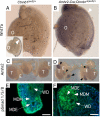Focal Mullerian duct retention in male mice with constitutively activated beta-catenin expression in the Mullerian duct mesenchyme
- PMID: 20805501
- PMCID: PMC2941287
- DOI: 10.1073/pnas.1011606107
Focal Mullerian duct retention in male mice with constitutively activated beta-catenin expression in the Mullerian duct mesenchyme
Abstract
Müllerian-inhibiting substance (MIS), which is produced by fetal Sertoli cells shortly after commitment of the bipotential gonads to testicular differentiation, causes Müllerian duct (MD) regression. In the fetal female gonads, MIS is not expressed and the MDs will differentiate into the internal female reproductive tract. We have investigated whether dysregulated β-catenin activity affects MD regression by expressing a constitutively activated nuclear form of β-catenin in the MD mesenchyme. We show that constitutively activated (CA) β-catenin causes focal retention of MD tissue in the epididymides and vasa deferentia. In adult mutant mice, the retained MD tissues express α-smooth muscle actin and desmin, which are markers for uterine differentiation. MD retention inhibited the folding complexity of the developing epididymides and usually led to obstructive azoospermia by spermatoceles. The MDs of urogenital ridges from mutant female embryos showed less regression with added MIS in organ culture compared with control MDs when analyzed by whole mount in situ hybridization for Wnt7a as a marker for the MD epithelium. CA β-catenin did not appear to affect expression of either MIS in the embryonic testes or its type II receptor (AMHR2) in the MD mesenchyme nor did it inhibit pSmad1/5/8 nuclear accumulation, suggesting that dysregulated β-catenin must inhibit MD regression independently of MIS signaling. These studies suggest that dysregulated Wnt/β-catenin signaling in the MD mesenchyme might also be a contributing factor in persistent Müllerian duct syndrome, a form of male pseudohermaphroditism, and development of spermatoceles.
Conflict of interest statement
The authors declare no conflict of interest.
Figures





References
-
- Teixeira J, Maheswaran S, Donahoe PK. Müllerian inhibiting substance: An instructive developmental hormone with diagnostic and possible therapeutic applications. Endocr Rev. 2001;22:657–674. - PubMed
-
- Josso N, Picard JY, Rey R, di Clemente N. Testicular anti-Müllerian hormone: History, genetics, regulation and clinical applications. Pediatr Endocrinol Rev. 2006;3:347–358. - PubMed
-
- Behringer RR, Finegold MJ, Cate RL. Müllerian-inhibiting substance function during mammalian sexual development. Cell. 1994;79:415–425. - PubMed
-
- Jamin SP, Arango NA, Mishina Y, Hanks MC, Behringer RR. Requirement of Bmpr1a for Müllerian duct regression during male sexual development. Nat Genet. 2002;32:408–410. - PubMed
-
- Clarke TR, et al. Mullerian inhibiting substance signaling uses a BMP-like pathway mediated by ALK2 and induces Smad6 expression. Mol Endocrinol. 2001;15:946–959. - PubMed
Publication types
MeSH terms
Substances
Grants and funding
LinkOut - more resources
Full Text Sources
Molecular Biology Databases
Research Materials
Miscellaneous

